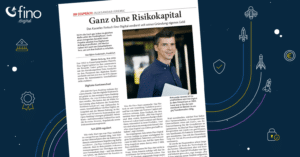You may have already read about our people-first approach on our website. About the fact that, true to our motto “Less finance #moreyou”, we don’t just deliver products, but bring our skills and our team to partners, co-create business models and take responsibility for their success. Today, we would like to introduce you to the term co-creation – and with it a key success factor in the current era.
The background is the evolution from the era of business-to-business (B2B) and business-to-consumer (B2C) to P2P, as innovator R “Ray” Wang describes the current situation in his book Disrupting Digital Business. He sees P2P not only as peer-to-peer, but also as people-to-people or point-to-point. This transformation is the linchpin and is changing business models. Just as the large networks Facebook, Twitter & Co. would only be empty shells without their users, who to a certain extent help shape the products, we are moving from the idea of with whom we enter into a partnership to the question of with whom we want to practice co-innovation and co-creation.
Co-creation puts customers at the center
The term “co-creation” is not new. It was coined at the turn of the millennium. It is a management approach that lets companies and customers collaborate to create synergy effects. This includes lower development costs and a shorter time-to-market. Above all, however, the customer or user is at the center. They are actively involved in the development process. Co-creation thus corresponds in a special way to the guiding principle of customer centricity. Innovation takes place in an open process. This is why co-creation is also called open innovation or co-innovation.
The main advantage is that, due to the influence of the customers, the products are developed according to their wishes and needs. Thus, one hundred percent relevant insights and experiences are used; the product fits and a wrong development is prevented. The process of co-creation strengthens the customer relationship and promotes innovation through the various competencies. This is also absolutely necessary. Because only a few companies in Germany have the necessary innovative strength to secure their competitive position in the long term, as the study “Innovative Milieus. Die Innovationsfähigkeit deutscher Unternehmen” by the Bertelsmann Stiftung shows. Small and medium-sized enterprises (SMEs) in particular often lack a pronounced culture of innovation. According to the study, innovation is directly linked to a company’s success. In principle, the more innovative a company is, the greater its economic success.
Leading technology – an energy boost for innovation
Incidentally, when asked what company leaders can do to drive innovation in their organizations, Bill McDermott, e-Head of SAP and CEO of ServiceNow, told Computerwoche that focusing on the customer experience is key. Since co-creation has a positive impact on this, co-creating products is a good answer to today’s challenges where the customer experience counts, as R “Ray” Wang also explains.
At fino, we specifically provide companies such as banks, insurance companies, management consultancies and developers with easy access to leading technologies and up-to-date know-how around account analysis, invoice management and data analysis. We establish bank account mining and account profiles behind all their services. Our mission is to exceed customer expectations and create real impact. This is how our customers and co-creators drive their innovation and improve their competitiveness.
What can we work on together with you?
My team and I are looking forward to joint projects.
Yours, Florian Christ
CEO



